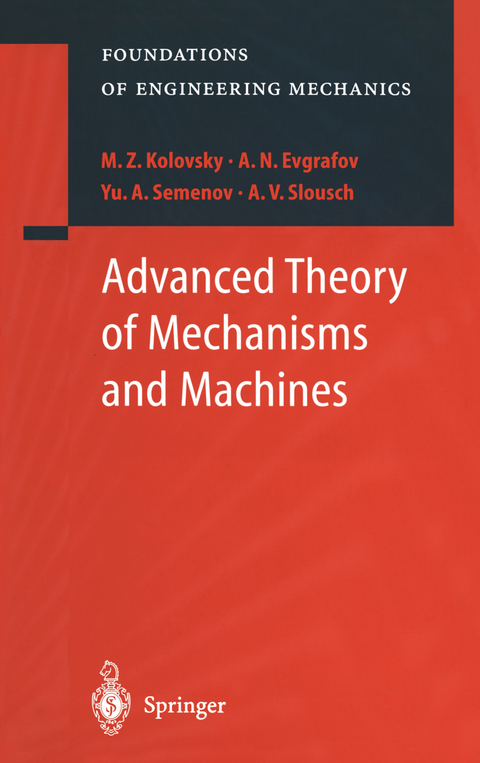
Advanced Theory of Mechanisms and Machines
Springer Berlin (Verlag)
978-3-642-53672-4 (ISBN)
1 Structure of Machines and Mechanisms.- 1.1 Machines and Their Role in Modern Production.- 1.2 Structure of a Machine and its Functional Parts.- 1.3 Mechanisms. Links and Kinematic Pairs.- 1.4 Kinematic Chains and Structural Groups. Generation of Mechanisms.- 1.5 Mechanisms with Excessive Constraints and Redundant Degrees of Movability.- 1.6 Planar Mechanisms.- 1.7 Mechanisms with Variable Structure. Strucural Transformations of Mechanisms.- 1.8 Examples of Structural Analysis of Mechanisms.- 1.9 Problems.- 2 Geometric Analysis of Mechanisms.- 2.1 Problems of Geometric Analysis.- 2.2 Geometric Analysis of Open Kinematic Chains.- 2.3 Derivation of Equations of Geometric Analysis for Closed Kinematic Chains.- 2.4 Solution to the Equations of Geometric Analysis.- 2.5 The Inverse Problem of Geometric Analysis.- 2.6 Special Features of Geometric Analysis of Mechanisms with Higher Kinematic Pairs.- 2.7 Problems.- 3 Kinematic and Parametric Analysis of Mechanisms.- 3.1 Kinematic Analysis of Planar Mechanisms.- 3.2 Kinematic Analysis of Spatial Mechanisms.- 3.3 Kinematic Analysis of a Mechanism with a Higher Pair.- 3.4 Kinematics of Mechanisms with Linear Position Functions.- 3.5 Parametric Analysis of Mechanisms.- 3.6 Problems.- 4 Determination of Forces Acting in Mechanisms.- 4.1 Geometric Conditions for Transmission of Forces by Mechanisms.- 4.2 Determination of Forces Acting in Mechanisms by the Graph-Analytic Method and the Method of Opening Kinematic Chains.- 4.3 Application of Equilibrium Equations of a Mechanism to its Kinematic and Parametric Analysis.- 4.4 General Formulation of the Force Analysis Problem.- 4.5 Equations of Kinetostatics. Determination of the Resultant Vector and of the Resultant Moment of Inertia Forces of Links.- 4.6 Solution of the Equations of Kinetostatics.- 4.7 Application of the General Equation of Dynamics for Force Analysis of Mechanisms.- 4.8 Force Analysis of Mechanisms with Higher Kinematic Pairs.- 4.9 Problems.- 5 Friction in Mechanisms.- 5.1 Friction in Kinematic Pairs.- 5.2 Models of Kinematic Pairs with Friction.- 5.3 Force Analysis of Mechanisms with Friction.- 5.4 Problems.- 6 Equations of Motion for a Mechanism with Rigid Links.- 6.1 Lagrange's Equations of the Second Kind for a Mechanism with a Single Degree of Movability.- 6.2 Lagrange's Equations of the Second Kind for Mechanisms with Several Degrees of Movability.- 6.3 An Example for Derivation of the Equations of Motion of a Mechanism.- 6.4 Problems.- 7 Dynamic Characteristics of Mechanisms with Rigid Links.- 7.1 Internal Vibration Activity of a Mechanism.- 7.2 Methods of Reduction of Perturbation Moments.- 7.3 External Vibration Activity of Mechanisms and Machines.- 7.4 External Vibration Activity of a Rotating Rotor and of a Rotor Machine.- 7.5 Balancing of Rotors.- 7.6 Vibration Activity of a Planar Mechanism.- 7.7 Loss of Energy due to Friction in a Cyclic Mechanism.- 7.8 Problems.- 8 Dynamics of Cycle Machines with Rigid Links.- 8.1 Mechanical Characteristics of Engines.- 8.2 Equations of Motion of a Machine. State of Motion.- 8.3 Determination of the Average Angular Velocity of a Steady-State Motion for a Cycle Machine.- 8.4 Determination of Dynamic Errors and of Dynamic Loads in a Steady-State Motion.- 8.5 Influence of the Engine Dynamic Characteristic on Steady-State Motions.- 8.6 Starting Acceleration of a Machine.- 8.7 Braking of a Machine.- 8.8 Problems.- 9 Dynamics of Mechanisms with Elastic Links.- 9.1 Mechanisms with Elastic Links and Their Dynamic Models.- 9.2 Reduction of Stiffness. Inlet and Outlet Stiffness andFlexibility of a Mechanism.- 9.3 Reduced Stiffness and Reduced Flexibility of a Mechanism with Several Degrees of Movability.- 9.4 Determination of Reduced Flexibilities with the Help of Equilibrium Equations of a Rigid Mechanism.- 9.5 Some Problems of Kinematic Analysis of Elastic Mechanisms.- 9.6 Dynamic Problems of Elastic Mechanisms.- 9.7 Free and Forced Vibration of Elastic Mechanisms.- 9.8 Problems.- 10 Vibration of Machines with Elastic Transmission Mechanisms.- 10.1 Dissipative Forces in Deformable Elements.- 10.2 Reduced Stiffness and Reduced Damping Coefficient.- 10.3 Steady-State Motion of a Machine with an Ideal Engine. Elastic Resonance.- 10.4 Influence of the Static Characteristic of an Engine on a Steady-State Motion.- 10.5 Transients in an Elastic Machine.- 10.6 Problems.- 11 Vibration of a Machine on an Elastic Base. Vibration Isolation of Machines.- 11.1 Vibration of the Body of a Machine Mounted on an Elastic Base.- 11.2 Vibration of a Machine in the Resonance Zone. Sommerfeld Effect.- 11.3 Vibration Isolation of Machines.- 11.4 Problems.- 12 Elements of Dynamics of Machines with Program Control.- 12.1 Basic Principles of Construction of Machines with Program Control.- 12.2 Determination of Program Control. Sources of Dynamic Errors.- 12.3 Closed Feedback Control Systems.- 12.4 Effectiveness and Stability of a Closed System.- 12.5 Problems.- References.
| Erscheint lt. Verlag | 30.8.2012 |
|---|---|
| Reihe/Serie | Foundations of Engineering Mechanics |
| Übersetzer | L. Lilov |
| Zusatzinfo | X, 396 p. 53 illus. |
| Verlagsort | Berlin |
| Sprache | englisch |
| Maße | 155 x 235 mm |
| Gewicht | 623 g |
| Themenwelt | Informatik ► Theorie / Studium ► Künstliche Intelligenz / Robotik |
| Mathematik / Informatik ► Mathematik ► Wahrscheinlichkeit / Kombinatorik | |
| Naturwissenschaften ► Physik / Astronomie ► Mechanik | |
| Technik ► Maschinenbau | |
| Schlagworte | Control • Design • Friction • inverse problem • Kinematics • mechanical engineering • Production • resonance • Rotor • stability • Structural Analysis • Vibration |
| ISBN-10 | 3-642-53672-7 / 3642536727 |
| ISBN-13 | 978-3-642-53672-4 / 9783642536724 |
| Zustand | Neuware |
| Haben Sie eine Frage zum Produkt? |
aus dem Bereich


